By AARON FIELDS
Today, many engine companies around the country will roll out the door to working fires with three or fewer crew members. The need to do more with less is a constant battle. Yet, regardless of staffing, engine companies around the country have little variation in tasks or equipment.
Fire conditions improve for civilians and interior crews with the rapid advancement of an attack line that is flowing water. Many engine companies find themselves temporarily or always understaffed; they have no choice but to face the situation as is.
There is no excuse for understaffed companies. At the ground level, members should make it a practice to assign additional crews to the initial handline. Understaffed lines separate nozzle teams, spreading crew members out on the line, which undermines handline advancement and fire attack. When the handline needs personnel, nothing replaces committing more hands to the line; a second or backup line can typically wait until the attack line is in place. There is nothing safer than a tapped fire; it happens more quickly with appropriate staffing and aggressive, appropriate application of water.
Although my current department places four firefighters (two tailboard members, a driver, and an officer) on every rig, my first department placed only three. It was there that I first developed and used the following two techniques; the primary role of the engine company is to advance the line into place and attack the fire.
The “Clamp” and the “Clamp Slide” are effective methods to help overcome a lack of staffing on the line. They are intended to allow the first-due company to effectively and quickly put an attack line into play.
There is a saying—”Work smarter, not harder.” Following are two methods that allow a nozzleman to manage either the 1¾- or 2½-inch handline without immediate help from the backup person, sometimes called the “heel.” On understaffed lines, the heel is often tasked with pulling hose, loading hose for the advance, searching the fire room, radio communication, and other various tasks. (Note that working smarter, not harder, does not imply that there is no work involved.)
The Clamp position is used when there is no longer a need to move. The Clamp Slide is a great way to advance the line until the nozzle team is in the proper position to flow water. Note that the Clamp and Clamp Slide, however, are not usable when a nozzle team needs to move and flow water simultaneously.
THE CLAMP
The Clamp is used for operating a handline while the line is stationary, whether you are in the fire room or on an exposure line. This technique is especially useful during 2½-inch hose operations where the backup person is not positioned directly behind the nozzle. The key here is to use the ankle/shin bone to press the line into the ground using your body weight (photos 1, 2). This way, the nozzle reaction is absorbed by the ground. This position allows for the most nozzle control and limits nozzle reaction. In effect, the nozzleman’s body weight replaces the backup man (the heel) and pins the line. The nozzleman’s knee is now on the far side of the hose and his toe is down on the side nearest the body. Once the line is open and is expected to flow for an extended duration, take the lead hand off the bail and place it behind the shank to avoid kinking the line while also directing the stream and to avoid an accidental partial closure of the line.
 |
| (1) A Clamp as the line is opened. While flowing, the nozzleman will remove his lead hand from the bail and place it behind the shank with the palm facing up. (Photos by author.) |
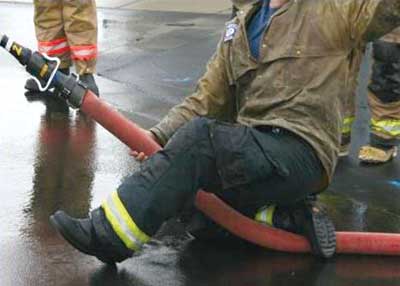 |
| (2) The nozzleman places his ankle over the line and drops his body weight down onto his foot, maximizing the point of friction and direct weight. |
While using the Clamp, the lead arm is on the same side as the raised leg. The nozzleman should tuck his foot under his rear end; this allows for his body weight to be transferred directly onto the hose and protects the knee from injuries (photo 3). The nozzleman needs enough hose in front of him to be able to direct the stream anywhere.
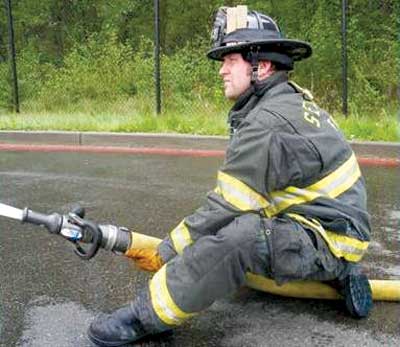 |
| (3) When he directs the stream, the use of the hips allows for the hands to fine-tune the lead length of line. Notice the hips can be rotated. |
The Clamp removes the need for a backup person to be stationed directly behind the nozzle. This frees the heel to perform other operations such as pulling hose, searching, and so on. In cases where the fire requires a “hit-and-move”-style attack, the Clamp Slide allows quick advancement and does not require a change in position.
Photos 4 and 5 show placement of the down leg when using the Clamp. Clearly, the back leg forces the hose into the ground, making the ground act as the backup person. The Clamp is also a good option for the heel, using it to pin the line behind the nozzleman when the line is stationary. Take care to set back about an arm’s length behind the nozzleman to avoid hindering his ability to direct the stream.
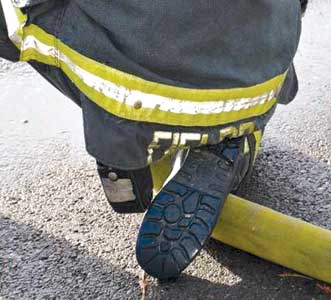 |
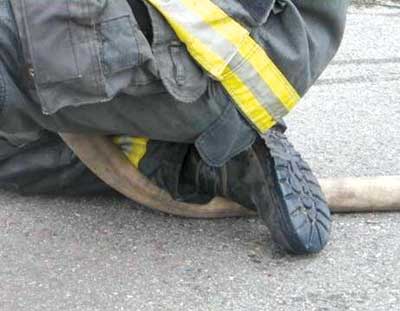 |
| (4, 5). Attention must be paid to keeping the hose pinned. |
THE CLAMP SLIDE
A quick way to advance hose while in a Clamp position is with the Clamp Slide. It maintains the same relative position to the hose during movement and eliminates reset and adjustment time, pre- and post-movement.
The nozzleman creates a tripod position by planting his back hand on the ground parallel with his lead foot (photo 6). He steps forward with the raised leg, swinging his down leg forward in a pendulum motion. The pendulum action of his leg and hips will push the hose forward. Meanwhile, the lead arm holds the hose and pulls back in time with the leg swing. This creates a lever motion and maintains the tension and spacing on the line. This levering of the line keeps the nozzleman from losing the line while traveling forward.
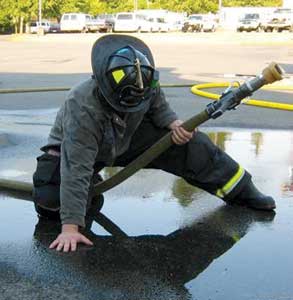 |
| (6) The setup for an advance from the Clamp: Notice the lead hand is in line with the lead leg. This allows the swing from the hips. |
The Clamp Slide is effective with a 2½-inch hose, but it is also more difficult because of the line’s size and weight. If the 2½-inch hose is too inflexible, one option to alleviate the pressure is to crack the nozzle. The nozzleman can also call for the advance and wait a split second until the heel begins to move. This will give less drag on the hose, as it is being, in effect, “pushed” to the nozzleman.
Typically on 2½-inch hose, the heel should be no more than 10 to 15 feet behind the nozzleman (photo 7). For 1¾-inch hose, the distance the nozzleman can travel without help increases. Nevertheless, the distance between the two members should be kept as close as possible. Don’t let the function of this technique stretch out the distance between personnel on the line.
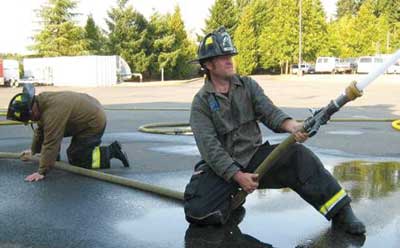 |
| (7) Spacing on the line between the nozzle person and the “heel” or backup man. |
Communication is essential on every handline. Communicate direction, distance, and timing up and down the line—silent lines are slow lines. With proper communication, the hoseline’s movement will not bog down, even in blacked-out conditions.
The Clamp Slide also makes it possible to maneuver through a building. The nozzleman will be able to turn corners by setting up a wide angle and driving his down leg around the corner.
One of the Clamp’s advantages is that it allows the nozzleman to remain stationary and make a fire attack without adjusting his body in relationship to the line. In a short advance or a hit-and-move situation, the Clamp Slide is fast and efficient. Also, pay attention to the hands; the left hand is the “operating hand,” which controls the nozzle. The right hand is the “control hand,” which controls the hose closer to the ground. Note that if the nozzleman has the left leg down, the hands switch roles.
Your body mechanics create a bight of hose; your body weight acts as a pendulum (photo 8). Besides the ease of movement, this method’s main advantage is that the nozzleman maintains proper spacing to allow for a rapid fire attack without readjustment (photo 9). Photos 10 and 11 illustrate the counter levering of the line combined with the drive of the shin.
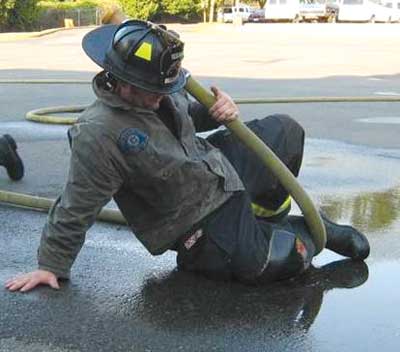 |
 |
| (8, 9) Here is the Clamp Slide midslide. Notice the line being levered back toward the left shoulder as the leg swings through. Think of the lower body as a pendulum. |
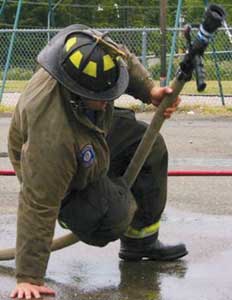 |
| (10) A good Clamp Slide should allow the nozzleman to reset into an attack position at the end of every move. |
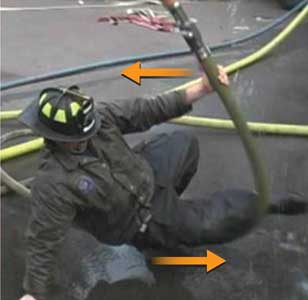 |
| (11) Sometimes there is a tendency to want to kick the leg through. Make sure you don’t “kick through”; the leg should be kept close so the reset is clean. |
Photo 12 shows the end of the Clamp Slide prior to resetting to the start or attack position. Notice that the angle of the bottom leg was maintained throughout the entire move.
(12) Close-up of the sliding leg with the hose and the contact point.
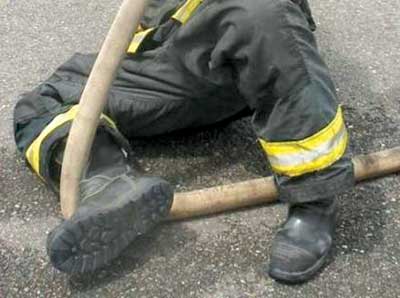 |
Photo 13 shows the bottom leg driving through and the top hand’s counter-lever.
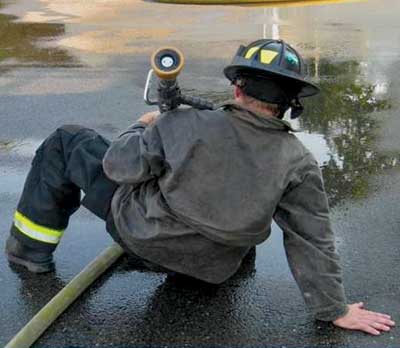 |
| (13) The Clamp Slide from behind. |
Engine companies from around the country have the same responsibilities. Large urban and rural departments have the same goal—protect the life of civilians inside the building by protecting the interior exposures, confining the fire to the seat, and extinguishing the main body of fire. Other than some small differences, the equipment they use is more or less the same. The biggest difference between the companies is the number of hands getting off the rig.
Other than rescue, your focus should be getting water on the seat of the fire. Fire hose and fire attack are the basis for fireground operations. Although staffing levels will affect the time it takes to accomplish various tasks on the fireground, there is no excuse for a lack of efficiency.
The burden of overcoming understaffed companies falls on the shoulders of those riding the rigs. We must strive to be excellent at our skill sets; it is a constant challenge to overcome the hurdles of the dynamic fireground. No matter how skilled firefighters become, the best they can hope for is meeting the expectations of their job. Water still puts fire out better than anything else.
● AARON FIELDS is a 12-year veteran of the fire service and assigned to Engine Company 28 of the Seattle (WA) Fire Department. He developed the “Nozzle Forward” techniques for improving engine company performance.
More Fire Engineering Issue Articles
Fire Engineering Archives

